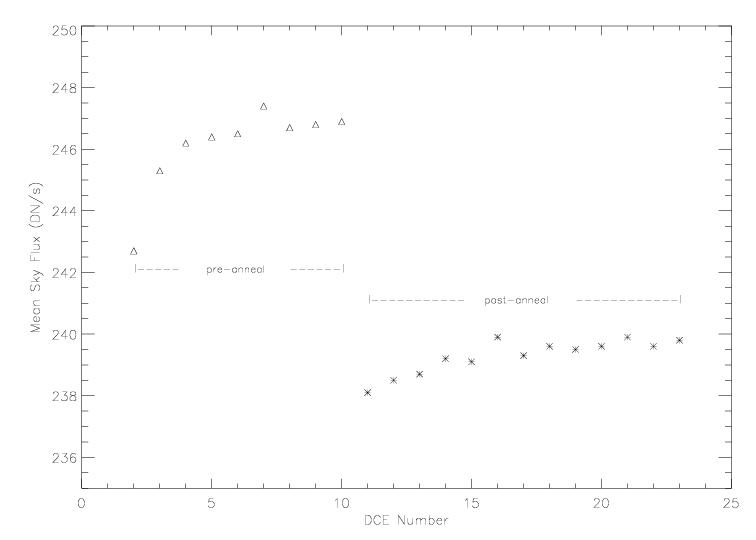
Principal:
Deputy:
Analyst:
AORKEYS:
Last Updated:
We converted the diagnostic data from the thermal anneal into temperatures and generated temperature plots. These data are compared to the temperature curves from previous anneals. These data are presented in the metatask writeup mips-2050.
We compared the 24um SUR data taken before and after the thermal anneal to look for changes in array behavior. The item of interest is the detector responsivity.
A Vrst analysis was performed on the Vrst data. In this test, the bias voltages for the 70um and 160um arrays are set to 0 mV, and then the Vrst voltages are adjusted between +5 mV and -5 mV relative to normal. A bright stim is turned on in manual mode during the test. The principle is that the array will produce a strong positive slope when positively biased and a strong negative slope when negatively biased, so the zero bias voltage point can be easily recognized. In practice, we calculate slope images and then look for this transition point.
filenames: mips_IER_7781376_gen_0_A24_Pukn_3s.fits
mips_IER_7781376_gen_(3-15)_A24_Pukn_3s.fits
DCE FrameMean FrameMedian
2 242.7 +/- 46.34 242.4
3 245.3 +/- 47.11 244.6
4 246.2 +/- 49.15 246.3
5 246.4 +/- 46.89 246.5
6 246.5 +/- 46.96 246.5
7 247.4 +/- 54.9 246.4
8 246.7 +/- 46.77 246.9
9 246.8 +/- 46.95 246.9
10 246.9 +/- 46.88 246.5
--- Thermal Anneal happened here ---
2 238.1 +/- 24.49 238.7
4 238.5 +/- 24.91 239.1
6 238.7 +/- 25.12 239.5
8 239.2 +/- 27.58 239.5
10 239.1 +/- 24.44 240.
12 239.9 +/- 34.22 240.2
14 239.3 +/- 24.74 239.8
16 239.6 +/- 25.34 239.9
18 239.5 +/- 25.34 240.7
20 239.6 +/- 25.03 240.3
22 239.9 +/- 26.16 240.8
24 239.6 +/- 24.81 240.8
26 239.8 +/- 25.07 240.9
The median sky flux is plotted below:

As mentioned in previous mips-992 writeups, the proper reference for the post-anneal data is the first data point from the pre-anneal data, which is the first DCE after a bias boost DCE. In this 16-hour long campaign, the change in Si detector response is about 1.3%.
The Vrst data are presented below. The filenames are MIPS.2/3.0007781376.00??.0001.01.mipl.fits. I ignored the last 72 frames in the 70um Vrst slope calculations. The 160um stim is brighter now than it used to be so I had to ignore 76 frames.
File Bias 70_1 70_2 70_3 70_4 70_5 70_6 70_7 70_8 160_1 160_2 160_3 160_4 03 Nom -30 -80 -120 -170 -180 -140 -110 -160 186 -196 22 43 04 +5 -220 -210 -290 -260 -330 -230 -300 -200 -913 -1356 -549 -405 05 +4 -140 -120 -190 -230 -240 -210 -220 -190 -890 -1120 -432 -258 06 +3 -90 -70 -130 -170 -180 -160 -170 -150 -485 -748 -278 -143 07 +2 -40 -20 -90 -120 -130 -160 -140 -130 -157 -475 -130 -58 08 +1 0 30 -50 -80 -90 -110 -100 -110 166 -255 5 30 09 Nom 30 70 -20 -40 -60 -90 -70 -80 482 -83 145 106 10 -1 80 120 20 -30 -40 -60 -50 -50 799 86 289 204 11 -2 120 170 60 10 -20 -20 -20 -40 1131 269 470 330 12 -3 150 190 100 40 20 20 20 -30 1534 471 627 478 13 -4 180 200 130 60 50 60 30 -10 1990 671 824 652 14 -5 210 220 190 80 130 90 60 10 2597 962 1057 891 15 Nom -70 -70 -90 -180 -230 -180 -200 -170 270 -82 113 115 Vrst +1.0 +1.5 -0.5 -1.5 -2.5 -2.5 -2.5 -4.5 +1.5 -0.5 +1.0 +1.25 DAC Counts +4 +6 -2 -6 -10 -10 -10 -18 +6 -2 4 +5 DAC NOM 90E 8F7 910 8E7 916 90B 920 905 97D 91C 91C 913 New DAC 912 8FD 90E 8E1 90C 901 916 8F3 983 91A 920 918